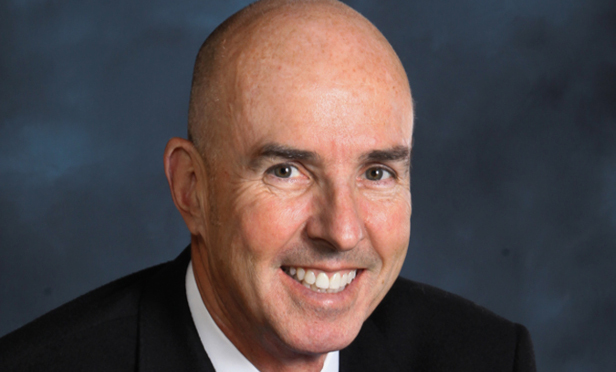
NEWPORT BEACH, CA— Each year, the demand for LEED buildings continues to grow as society becomes more interested in sustainability and gains a better understanding of the benefits of green office buildings, Mark IV Capital's CEO's Paul Cate tells GlobeSt.com. The firm's headquarters building here was recently awarded this designation and is one of only two LEED-Platinum office buildings in Newport Beach.
The two-story, 20,389-square-foot office building, located at 4450 MacArthur Blvd., houses Mark IV Capital, TIAA-CREF and Chronos. Its green features include an energy-efficient shell with rooftop solar panels, high-performance glazing, low-emission building materials, water-friendly landscaping and a custom-made building automation and energy-management control system. High-performance interior elements include energy-efficient LED lighting, water-saving plumbing fixtures and low-emitting finishes including low VOC paints, adhesives, flooring, composite-wood products and furniture systems. An operable window system ensures a healthy indoor environment for employees and tenants.
The team adhered to a strong Indoor Air Quality Management Plan throughout the construction process to keep contaminants out of the building and enhance indoor air quality immediately upon occupancy. On the roof, Mark IV added a 20-kW rated photovoltaic system that boosted the project from LEED Gold to LEED Platinum. Combined onsite generation and natural ventilation technologies enable the project to meet and exceed set energy targets by greater than 50% of baseline projections.
We spoke with Cate about the demand for green office buildings and for wellness in office buildings and how these qualifications are helping investor value.

GlobeSt.com: Is the demand for green office buildings as strong as it has been in recent years?
Cate: Yes. We believe that each year the demand for LEED buildings continues to grow as society becomes more interested in sustainability and gains a better understanding of the benefits of green office buildings. In addition, more and more companies are implementing sustainability initiatives that require them to evaluate and address their carbon footprint. Those pursuing these initiatives understand that a green building will provide cost savings in the form of better building performance, greater appreciation of the work environment by their workforce and recognition in the community of their organization's efforts to be a responsible global citizen.
GlobeSt.com: What about the demand for wellness in office buildings?
Cate: A healthy work environment is important to building occupants, as evidenced at 4450 MacArthur.
Employees really enjoy the experience, from stand-up desks that help their circulation throughout the day to operable window systems that bring fresh air inside. When we recruit new employees, they are impressed by the notion that they can be in an environment that is set up for their personal health and success. A LEED building improves the health of employees, but it also improves productivity and reduces turnover rates, which saves money for the business owner. Another important consideration is the impact of California's recent drought. Having low-flow toilets and drought-tolerant landscaping has been a big factor in maintaining costs, and the landscape quality holds up much better with limited water. For Mark IV Capital, this LEED-Platinum-certified facility helps our organization live out a sustainability goal of building for quality and the long term. We can make a positive impact on the environment and our employees while further supporting our fiscal responsibility.
GlobeSt.com: How are these qualifications helping investor value?
Cate: LEED designation is a brand that demonstrates that the building is of a higher quality than the competition. A LEED-certified building is going to operate more efficiently: lowering operating costs, raising NOI and thus increasing the fair market value of the property. In addition, it provides a greater magnet for tenants: driving rate and occupancy, while reducing vacancy. USGBC cites that upfront investment in green building makes properties more valuable, with an average expected increase in value of 4%, and green retrofit projects are generally expected to pay for themselves in just seven years. These values are often not easy to quantify, but it is clear that additional value is created. With a long-term approach to holding real estate assets, we believe that this value differentiation will continue to increase over time.
GlobeSt.com: What do you see as the next wave of tenant demands in office buildings?
Cate: Outdoor space is increasingly important for employees. Today, tenants and their workforce are evaluating not only the building interiors, but also the outdoor experience that is contiguous. Here, we believe it is important to provide outdoor areas for breaks, lunch and even a location where someone can take a respite and answer e-mail or make a phone call in an alternative environment. These areas provide an element of freedom for employees: the freedom to choose alternative areas to work. To address this, we are always looking for logical locations for such amenities, including rooftop patios that provide tremendous views. In addition, today's workforce is looking for freedom inside: interior offices, open glass lines, high ceilings and lots of natural light throughout the interior space.
© 2025 ALM Global, LLC, All Rights Reserved. Request academic re-use from www.copyright.com. All other uses, submit a request to [email protected]. For more information visit Asset & Logo Licensing.







